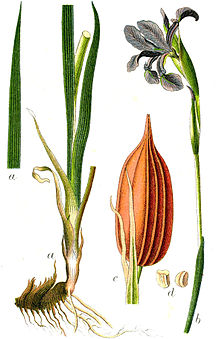Bastard iris
| Bastard iris | ||||||||||||
|---|---|---|---|---|---|---|---|---|---|---|---|---|

Bastard Iris ( Iris spuria ) |
||||||||||||
| Systematics | ||||||||||||
|
||||||||||||
| Scientific name | ||||||||||||
| Iris spuria | ||||||||||||
| L. |

The iris spuria ( Iris spuria ), also salt marsh iris , is a plant from the genus of the iris ( Iris ).
description
The bastard iris is a perennial , herbaceous plant that reaches heights of between 30 and 50 centimeters. The species is a cryptophyte and forms a branched rhizome underground . The stem is upright and almost round, it usually has more than two stem leaves . The rigid upright basal leaves are between 25 and 90 cm long but only between 0.5 and 1.5 cm narrow. If they are rubbed between the fingers, they give off a strong, unpleasant odor.
From May to June the plants usually develop between two and four flowers , but sometimes remain single-flowered. The flower stalks are 1 to 2 cm long. The hermaphrodite flowers are threefold. There are six bracts that are fused together like a trumpet; three outer so-called "hanging leaves" and three inner "standards". The hanging leaves are blue-violet and whitish-yellowish at the base, they are beardless and veined red-violet. The standards are purple.
In the case of fertilized flowers, capsule fruits are formed , which belong to the so-called loculicidal capsules . When ripe, they tear open at the back seams of each carpel.
The number of chromosomes is 2n = 22.
distribution
The main distribution area of the bastard iris is in southern Europe and the Mediterranean area . Isolated occurrences can be found south of Mainz , and very small occurrences in Lower Austria and Burgenland in the area of the Pannonian flora . Occurrences in the Øresund region have also been known since 1955 .
For the population in Rhineland-Palatinate , the species has its distribution center in the Bodenheimer Aue and spreads somewhat to the south in the northern part of the Mannheim-Oppenheimer Rhine lowlands. It is one of the extremely rare types of river valley in Rhineland-Palatinate. It has its ecological focus in the drier areas of the river valley meadows and thus shows tendencies towards Cirsio tuberosi-Molinietum arundinaceae.
The occurrences near Mainz described above could possibly be of natural origin, they would then be the relict site of an area formerly extending to the west, which the species would have reached in one of the unification periods of the following warm period . The other locations in Germany were all created by human hands, as the species is traditionally kept as an ornamental plant . It must have broken out of culture or was planted out.
In general, the species needs a sunny location on a neutral to alkaline, well-drained, sandy-loamy soil.
Systematics
In addition to the nominotypical taxon Iris spuria subsp. spuria there are still several subspecies of the bastard iris.
- Iris spuria subsp. carthaliniae (Fomin) B.Mathew : It occurs in the Caucasus.
- Iris spuria subsp. demetrii (Achv. & Mirzoeva) B.Mathew : It occurs from northeastern Turkey to Transcaucasia.
- Iris spuria subsp. musulmanica (Fomin) Takht. : It occurs from Turkey to Iran.
- Iris spuria subsp. spuria : It occurs from Central Europe to southern Sweden.
No longer belongs to this species:
- Iris spuria subsp. guldenstaedtiana (Lepech.) Soldano => Iris halophila var. halophila viewed.
- Iris spuria subsp. maritima (Dykes) P. Fourn. => Irisreichenbachiana Klatt
- Iris spuria subsp. notha (M.Bieb.) Asch. & Graebn. => Iris notha M. Bieb.
- Iris spuria subsp. sogdiana (Bunge) B. Mathew => Iris halophila var. sogdiana (Bunge) Grubov .
Culture
The bastard iris is traditionally a frost-hardy cultivated plant in gardens. The species was bred for a long time and a large number of different varieties were produced. A yellow hybrid Iris spuria 'Candle Lace' and a light purple Iris spuria 'Anacapa' are famous , as are many other breeds.
Individual evidence
- ^ Erich Oberdorfer : Plant-sociological excursion flora for Germany and neighboring areas . With the collaboration of Angelika Schwabe and Theo Müller. 8th, heavily revised and expanded edition. Eugen Ulmer, Stuttgart (Hohenheim) 2001, ISBN 3-8001-3131-5 , pp. 142 .
- ^ Mattiasson, Göran: Iris spuria - Dansk iris / ArtDatabanken - artfactablad. Retrieved August 30, 2016 (Swedish).
- ↑ http://www.luwg.rlp.de/internet/nav/f08/broker.jsp?uMen=a23191ce-8b53-6013-3e2d-cfc638b249d6 ( page no longer available , search in web archives ) Info: The link was created automatically marked as defective. Please check the link according to the instructions and then remove this notice. State Office for the Environment, Water Management and Trade Inspectorate Rhineland-Palatinate
- ↑ https://npgsweb.ars-grin.gov/gringlobal/taxonomydetail.aspx?20409 Entry in the Germplasm Resources Information Network (GRIN)
- ↑ a b c d e f g h i Rafaël Govaerts (Ed.): Iris spuria. In: World Checklist of Selected Plant Families (WCSP) - The Board of Trustees of the Royal Botanic Gardens, Kew . Retrieved July 25, 2018.
literature
- Dietmar Aichele, Heinz-Werner Schwegler: The flowering plants of Central Europe, Volume 5, swan flower plants to duckweed plants. Page 142, Franckh-Kosmos, Stuttgart 1995. ISBN 3-440-06195-7
- J. Bernátsky and E. Janchen: About Iris spuria L., I. spathulata Lam. and I. subbarbata Joó in Österreichische Botanische Zeitschrift, Volume 60, Number 9 / September 1910, Pages 335–343, doi : 10.1007 / BF01637842
Web links
- Bastard iris. In: FloraWeb.de.
- Bastard iris . In: BiolFlor, the database of biological-ecological characteristics of the flora of Germany.
- Profile and distribution map for Bavaria . In: Botanical Information Hub of Bavaria .
- Distribution in the northern hemisphere from: Eric Hultén , Magnus Fries: Atlas of North European vascular plants 1986, ISBN 3-87429-263-0 at Den virtuella floran (swed.)
- Thomas Meyer: Data sheet with identification key and photos at Flora-de: Flora von Deutschland (old name of the website: Flowers in Swabia )
- Description in the Flora of Pakistan (in English)